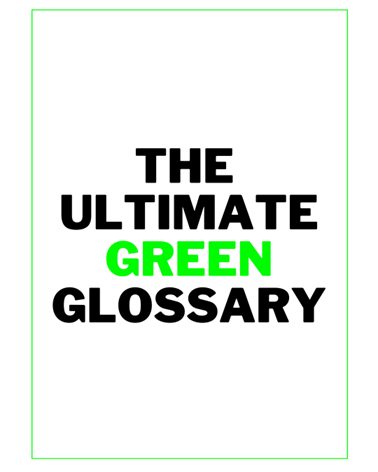
The mysteries of the environment are endless and so are the new terms around it. Everyday we come across with different words that we may not know what they mean. Words with high importance that hide inside them the true power of knowledge about environmental issues.
We tried to make things clearer by choosing 5 significant words and giving their meanings making the Ultimate Green Glossary.
Sustainability
Sustainability refers to the ability of current generations to meet their needs without compromising the ability of future generations to meet their own needs. It involves using resources in a way that is environmentally friendly, economically viable, and socially equitable.
The goal of sustainability is to achieve a balance between economic prosperity, social well-being, and environmental protection. This requires a shift towards renewable and sustainable forms of energy, reducing waste and pollution, protecting biodiversity, and promoting social justice. Sustainability aims to create a better world for both present and future generations.
Eco-friendly
Eco-friendly refers to anything that is not harmful to the environment. It implies that the product or service reduces or eliminates its impact on the planet. Eco-friendly practices include using renewable resources, reducing waste, and minimizing carbon emissions.
Examples of eco-friendly products include compostable packaging, biodegradable cleaning products, and energy-efficient appliances. Adopting eco-friendly solutions in everyday life can help preserve the environment for future generations.
Many companies are now incorporating eco-friendliness into their business operations to meet the demands of socially conscious consumers and promote sustainable development.
Textile Pollution
Textile pollution refers to the harmful environmental effects caused by the production, use, and disposal of textiles. It is a significant contributor to global waste and emissions, including greenhouse gasses and toxic chemicals.
The production of fabrics involves large quantities of water, energy, and other resources, leading to high levels of resource depletion and environmental degradation. The disposal of textiles in landfills also contributes to environmental pollution and health hazards from toxic chemicals released into the environment.
Textile industries are under increasing pressure to adopt more sustainable practices to reduce textile pollution and promote a cleaner, healthier planet.
Upcycling
Upcycling is the process of turning waste materials or useless products into something of higher value or quality. It involves creative thinking and repurposing discarded or unused items to give them a new life and purpose.
Upcycling is seen as a sustainable alternative to traditional recycling, as it reduces the amount of waste produced and helps to conserve natural resources. Upcycling is a popular trend in the fashion industry, where designers use old clothing and materials to create new, unique pieces. It is also commonly used in DIY projects, home decor, and furniture design.
Recycling
Recycling is the process of converting waste materials into new products. It involves collecting and processing materials that would otherwise be thrown away as trash and turning them into new products.
Recycling helps to reduce the amount of waste sent to landfills and can also conserve natural resources by reducing the need for virgin materials. It also helps to reduce greenhouse gas emissions that contribute to climate change.
Commonly recycled materials include paper, plastic, glass, and metal. Many countries have implemented recycling programs to encourage the practice of recycling and reduce waste.
